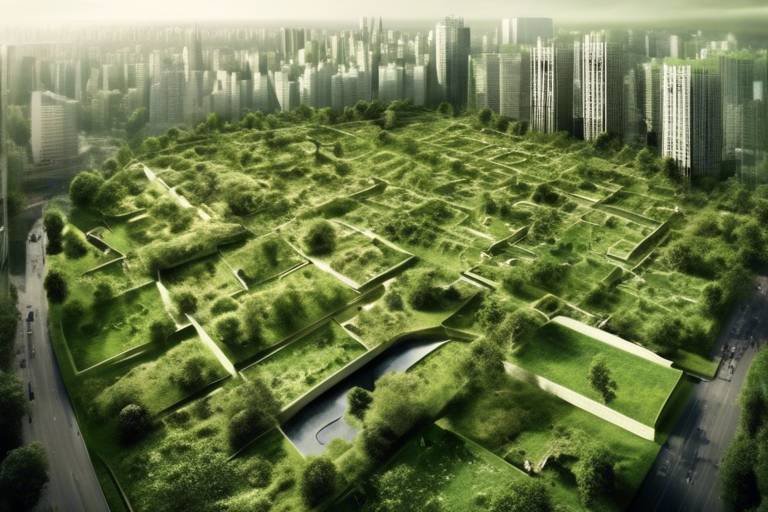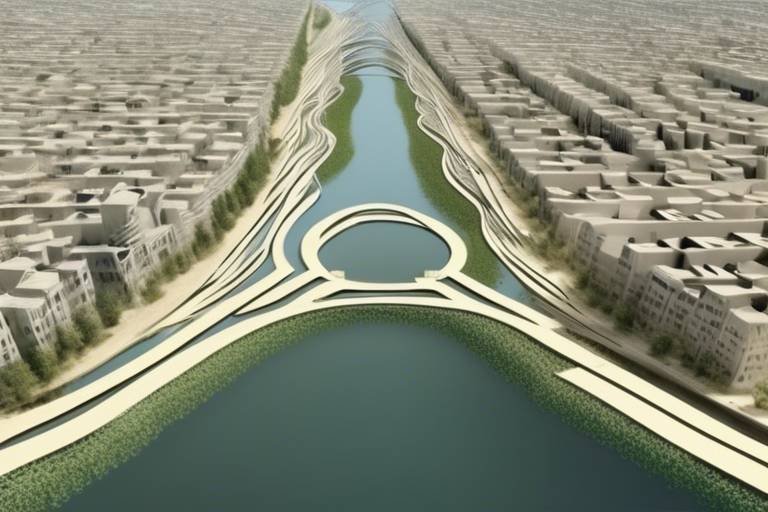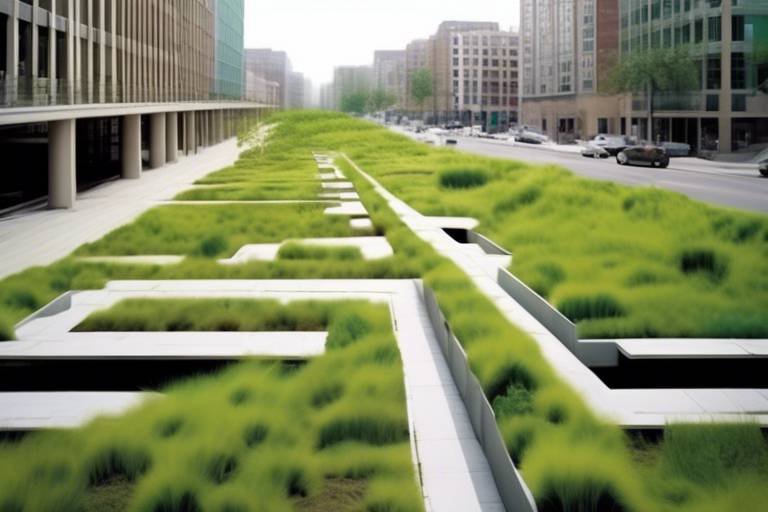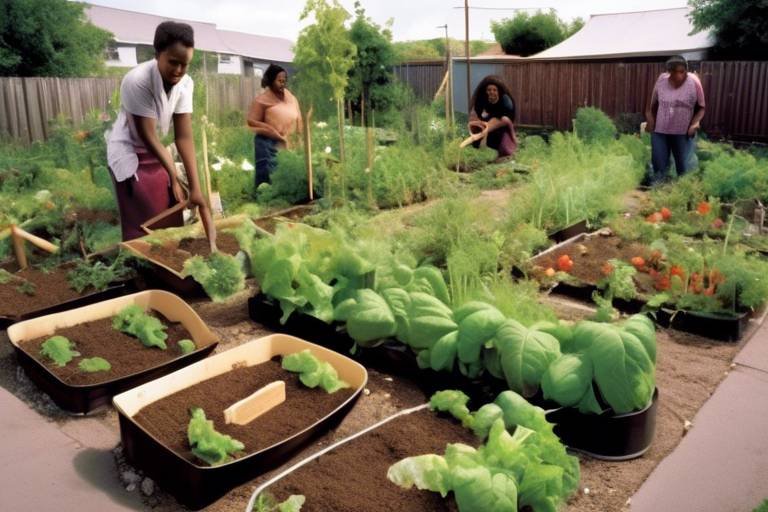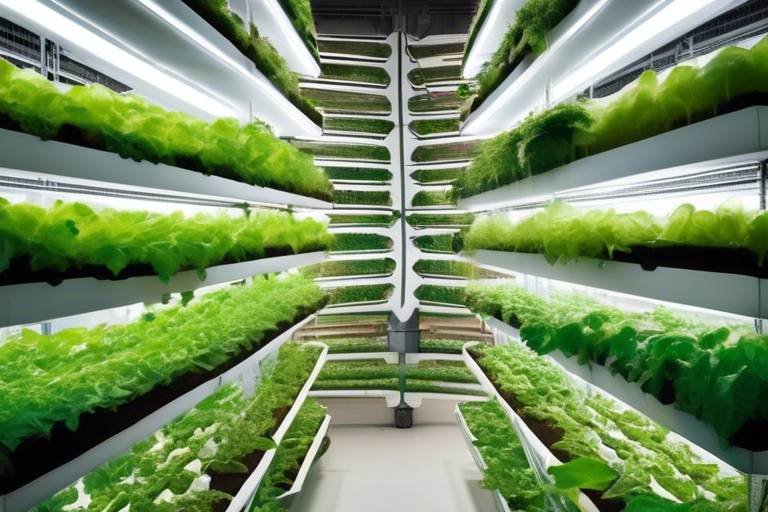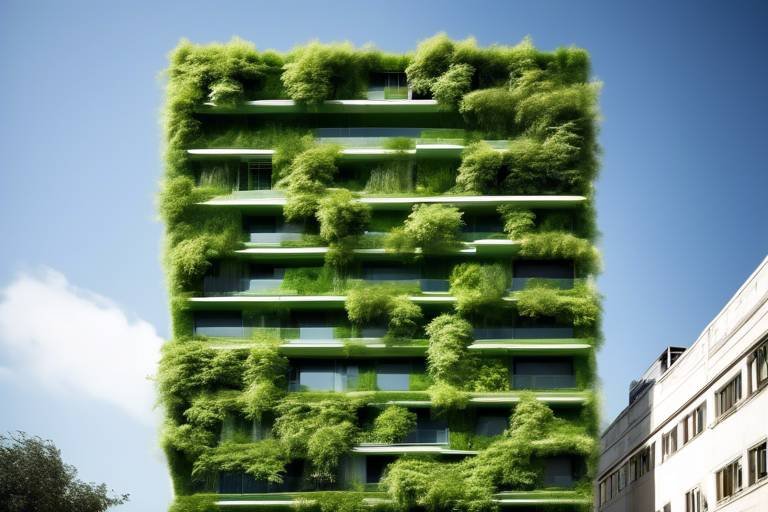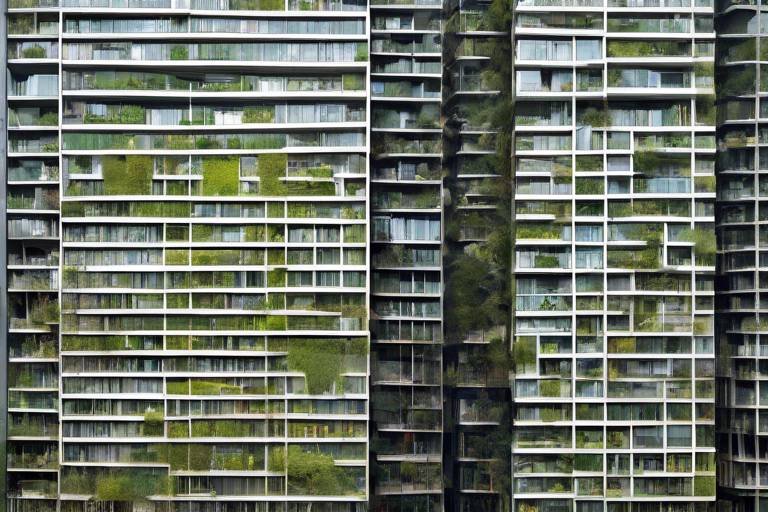Implementation and Benefits of Green Streets in Cities
The concept of green streets is rapidly gaining traction in urban planning, and for good reason. As cities expand and populations swell, the need for sustainable infrastructure becomes increasingly critical. Green streets are not just a trend; they represent a fundamental shift in how we view urban environments. By integrating natural elements into the fabric of our cities, we can address pressing issues such as stormwater management, air quality, and even community well-being. But what exactly are green streets, and how can they be effectively implemented to reap their myriad benefits?
At their core, green streets are urban designs that seamlessly blend vegetation with sustainable practices. They are engineered to manage stormwater runoff and enhance the overall urban landscape. Imagine walking down a street where lush greenery thrives alongside pedestrian pathways, where the air feels fresher, and the sound of birds chirping fills your ears. This is the vision of green streets—a space that promotes biodiversity and improves air quality while also providing aesthetic value. By incorporating elements like trees, plants, and permeable surfaces, green streets create a harmonious balance between nature and urban life.
The successful implementation of green streets involves several key components that work together to create a sustainable urban ecosystem. Among these are permeable pavements, bioswales, and native plant selection. Each of these elements plays a crucial role in ensuring that green streets function effectively while also enhancing the beauty of our cities.
One of the standout features of green streets is the use of permeable pavements. These innovative surfaces allow rainwater to infiltrate through them, significantly reducing runoff. Think of it like a sponge soaking up water; permeable pavements promote groundwater recharge, which is essential for maintaining the water table in urban areas. This not only helps in managing stormwater but also minimizes the risk of flooding, a common concern in densely populated cities.
Bioswales are another integral component of green streets. These landscape elements are specifically designed to concentrate and convey stormwater runoff while filtering out debris and pollutants. Imagine a natural filtration system that cleans the water before it enters our rivers and lakes. By integrating bioswales into the urban landscape, cities can significantly improve water quality, making them cleaner and safer for both humans and wildlife.
Choosing native plants for green streets is a game-changer. Native plants are adapted to the local climate and soil conditions, making them easier to maintain. They require less water and are more resilient to pests, reducing the need for chemical treatments. Additionally, these plants create habitats for local wildlife, enhancing urban biodiversity. When you walk down a street lined with native flora, you’re not just enjoying a beautiful view; you’re also supporting the local ecosystem.
One of the most significant benefits of green streets is their ability to improve stormwater management. By reducing the volume of runoff and enhancing water quality through natural filtration processes, green streets contribute to healthier urban ecosystems. This is crucial as cities face increasing challenges related to climate change and extreme weather events. With effective stormwater management, we can mitigate the risks of flooding and protect our water resources.
Beyond their environmental benefits, green streets also offer substantial social and economic advantages. For instance, they can lead to increased property values as neighborhoods become more attractive to potential buyers. Furthermore, the creation of green spaces enhances community spaces, encouraging social interaction and fostering a sense of belonging. People are naturally drawn to areas that offer greenery and open spaces, which can lead to improved public health outcomes.
Green streets also promote community engagement in urban planning. When residents are involved in the design and implementation of green spaces, they develop a sense of ownership and pride in their neighborhoods. This can lead to stronger community bonds and a collective effort to maintain these spaces, making them vibrant parts of urban life.
The incorporation of green spaces in urban areas has been shown to promote physical activity and mental well-being. Parks and green streets provide residents with places to walk, jog, or simply relax, contributing to better public health outcomes. Imagine a bustling city where people are not just rushing from one place to another but are instead taking the time to enjoy their surroundings. This shift can transform urban living into a more fulfilling experience.
Despite the numerous benefits of green streets, their implementation can face several challenges. Funding constraints often limit the ability of cities to invest in these sustainable infrastructures. Additionally, maintenance issues can arise if proper care is not taken to ensure the longevity of these green spaces. Finally, public education on the importance and functionality of green streets is crucial. Without community support and understanding, even the best-designed green streets may struggle to thrive.
- What are green streets? Green streets are urban designs that integrate vegetation and sustainable practices to manage stormwater and enhance the urban landscape.
- How do green streets benefit the environment? They improve stormwater management, reduce flooding risks, and enhance air quality by promoting biodiversity.
- What are the key components of green streets? Key components include permeable pavements, bioswales, and the selection of native plants.
- How can green streets improve public health? They promote physical activity and provide spaces for relaxation, contributing to better overall health outcomes.

Understanding Green Streets
Green streets represent a revolutionary approach to urban design, where the integration of nature and infrastructure creates a harmonious balance that benefits both the environment and the community. Imagine walking down a city street where the pavement is interspersed with lush greenery, vibrant flowers, and trees that provide shade and beauty. This isn’t just a dream; it’s the essence of what green streets aim to achieve. By incorporating elements like vegetation, permeable surfaces, and sustainable practices, green streets manage stormwater effectively while enhancing the aesthetic appeal of urban areas.
At their core, green streets are designed to tackle some of the most pressing challenges faced by cities today, such as flooding, pollution, and the urban heat island effect. When it rains, traditional streets often lead to excessive runoff, overwhelming drainage systems and polluting local waterways. Green streets, on the other hand, utilize natural processes to absorb and filter rainwater. These streets not only manage stormwater but also promote biodiversity by creating habitats for various species of plants and animals. This is crucial for urban ecosystems that often struggle to support wildlife due to habitat loss.
Furthermore, the incorporation of greenery into urban landscapes has profound effects on air quality. Plants act as natural air filters, absorbing carbon dioxide and releasing oxygen. The presence of trees and vegetation can lower temperatures, making cities more livable during the hot summer months. In essence, green streets are not just about beautification; they are a vital part of creating resilient urban environments that can adapt to climate change.
To truly understand the impact of green streets, consider these key aspects:
- Stormwater Management: By slowing down and absorbing rainwater, green streets reduce the risk of flooding and help recharge groundwater supplies.
- Urban Biodiversity: They provide essential habitats for various species, contributing to healthier ecosystems within cities.
- Air Quality Improvement: The greenery helps filter pollutants and improve air quality, benefiting public health.
In conclusion, green streets are a transformative concept that blends ecological responsibility with urban development. They represent a shift towards more sustainable cities, where nature and infrastructure coexist for the benefit of all. As cities continue to grow and face environmental challenges, embracing the principles of green streets will be crucial for fostering healthier, more vibrant urban communities.

Key Components of Green Streets
To create an effective green street, several key components must be thoughtfully integrated into the urban landscape. These elements not only enhance the aesthetic appeal of the area but also play a crucial role in promoting environmental sustainability. Imagine walking down a street where the pavement seems to breathe, allowing rainwater to seep into the ground rather than flooding the sidewalks. This is just one of the wonders of green street design.
One of the most vital components is permeable pavements. These innovative surfaces allow water to infiltrate through them, significantly reducing surface runoff. Picture a sponge absorbing water; that’s how permeable pavements work, helping to recharge groundwater supplies and mitigate flooding. They are available in various materials, including porous asphalt and interlocking concrete pavers, which provide both functionality and aesthetic diversity.
Next up are bioswales. These landscaped elements are designed to manage stormwater runoff efficiently. Think of them as nature's filtration systems; they slow down water flow, allowing it to be absorbed by the soil while filtering out pollutants and debris. By strategically placing bioswales along streets, cities can enhance their stormwater management strategies significantly. For instance, a well-designed bioswale can reduce the volume of runoff entering storm drains, which ultimately protects local waterways from contamination.
Another essential aspect of green streets is the selection of native plants. Choosing plants that are indigenous to the area not only ensures lower maintenance costs but also supports local wildlife and biodiversity. Native plants are adapted to the local climate and soil conditions, making them more resilient and less reliant on irrigation and fertilizers. Imagine a vibrant street lined with colorful flowers and lush greenery, all thriving effortlessly in their natural habitat. This not only beautifies the urban environment but also creates habitats for pollinators and other wildlife.
Incorporating these components creates a harmonious balance between nature and urban living. However, it's essential to consider how these elements work together. For example, permeable pavements can direct water to bioswales, where it can be filtered and absorbed by native plants, creating a sustainable cycle that benefits the entire ecosystem. By integrating these components, cities can transform ordinary streets into green corridors that promote ecological health and enhance the quality of life for residents.
Furthermore, the impact of these components extends beyond aesthetics and functionality. They contribute significantly to reducing urban heat islands, improving air quality, and enhancing the overall livability of neighborhoods. The combination of permeable surfaces, natural filtration systems, and native flora creates a robust framework for sustainable urban development.
In summary, the key components of green streets—permeable pavements, bioswales, and native plants—work synergistically to create resilient urban environments. They not only manage stormwater effectively but also foster a sense of community and connection to nature. As cities continue to grow and evolve, embracing these elements will be crucial in building sustainable and vibrant urban spaces.

Permeable Pavements
Permeable pavements are a revolutionary element in the design of green streets, serving as a **sustainable solution** to urban drainage issues. Unlike traditional pavements, which can create an impermeable barrier, permeable pavements allow water to flow through their surfaces, effectively reducing **stormwater runoff**. This innovative approach not only helps manage excess water during heavy rains but also promotes the natural replenishment of groundwater supplies. Imagine a sponge soaking up water; that's how permeable pavements work, soaking up rainfall and allowing it to filter down into the ground rather than flooding our streets.
There are various types of permeable pavements, including porous asphalt, permeable concrete, and interlocking pavers. Each type has its unique characteristics and benefits, making them suitable for different applications. For instance, porous asphalt is often used in parking lots, while interlocking pavers can enhance the aesthetic appeal of walkways and plazas. The choice of material can depend on factors such as soil type, climate, and intended use. Here’s a quick comparison of some common types:
| Type of Permeable Pavement | Benefits | Ideal Use |
|---|---|---|
| Porous Asphalt | High permeability, easy to install | Parks, parking lots |
| Permeable Concrete | Durable, supports heavy loads | Roadways, driveways |
| Interlocking Pavers | Customizable design, aesthetic appeal | Walkways, plazas |
One of the most significant advantages of permeable pavements is their role in **stormwater management**. By allowing rainwater to seep through, they help to prevent flooding in urban areas, which is a growing concern as climate change intensifies precipitation patterns. Furthermore, as water filters through these pavements, it undergoes a natural **filtration process** that removes pollutants before it reaches the groundwater. This means that not only are we managing stormwater effectively, but we are also improving the quality of water that replenishes our aquifers.
In addition to environmental benefits, permeable pavements can enhance the **aesthetic quality** of urban spaces. They can be designed to blend seamlessly with the surrounding landscape, providing a more natural look than traditional asphalt or concrete. This can create a more inviting atmosphere for pedestrians and cyclists, encouraging outdoor activities and community engagement. In essence, permeable pavements are not just functional; they are a vital part of creating beautiful, sustainable urban environments.
However, it’s essential to consider that the effectiveness of permeable pavements can be influenced by **maintenance practices**. Regular upkeep, such as cleaning to prevent clogging, is necessary to ensure their long-term performance. This brings us to the importance of community education and involvement. By engaging local residents in maintenance efforts, cities can foster a sense of ownership and responsibility towards these green infrastructures.
- What are permeable pavements made of? Permeable pavements can be made from materials like porous asphalt, permeable concrete, and interlocking pavers that allow water to pass through.
- How do permeable pavements help with flooding? They allow rainwater to infiltrate the ground, reducing surface runoff and consequently lowering the risk of flooding.
- Do permeable pavements require special maintenance? Yes, they require regular cleaning to prevent clogging and maintain their effectiveness.
- Can permeable pavements be used in all climates? While they can be effective in various climates, local conditions such as soil type and rainfall patterns should be considered when selecting the appropriate type.

Bioswales
Bioswales are not just a trendy term in urban planning; they are essential components of green streets that help manage stormwater effectively. Imagine a lush, green corridor that not only beautifies a city but also acts as a natural sponge, soaking up rainwater and filtering out pollutants before they reach our waterways. That's what bioswales do! These landscape features are designed to concentrate and convey stormwater runoff, allowing it to infiltrate the ground rather than overwhelming our sewer systems. Picture a gentle slope lined with native plants and grasses, where rainwater can trickle down, nourishing the earth while simultaneously cleaning itself. Isn’t that a win-win?
One of the most impressive aspects of bioswales is their ability to improve urban water quality. When rain falls on our streets, it often carries debris, oils, and other pollutants into storm drains, which can lead to contaminated rivers and lakes. However, with bioswales in place, stormwater is directed into these vegetated channels where it undergoes a natural filtration process. The plants and soil work together to absorb harmful substances, breaking them down and allowing clean water to return to the groundwater table. This not only benefits the environment but also helps maintain the health of our ecosystems.
Moreover, bioswales can be customized to fit the specific needs of a community. They can vary in size, shape, and plant selection based on local conditions and the volume of stormwater they need to manage. For instance, in areas prone to heavy rains, larger bioswales with deeper soil layers might be necessary, while smaller urban settings could benefit from compact designs that still deliver substantial impact. This flexibility makes bioswales a practical solution for cities of all sizes.
To illustrate their effectiveness, let’s take a look at a simple comparison table that outlines the benefits of bioswales:
| Benefit | Description |
|---|---|
| Stormwater Management | Reduces runoff and minimizes flooding risks by allowing water to infiltrate into the ground. |
| Pollution Reduction | Filters out contaminants from stormwater, improving overall water quality. |
| Biodiversity Support | Provides habitats for various species of plants and wildlife. |
| Aesthetic Appeal | Enhances the visual landscape of urban areas, making them more inviting. |
In conclusion, bioswales are more than just functional elements of green streets; they are a testament to how nature can work alongside urban development to create healthier, more sustainable cities. By integrating these natural systems into our urban landscapes, we not only tackle stormwater issues but also create spaces that foster community pride and environmental stewardship. So, next time you see a bioswale, remember that it’s doing its part to keep our cities vibrant and thriving!
- What exactly is a bioswale? A bioswale is a landscape feature designed to manage stormwater by allowing it to flow through a vegetated area where it can be filtered and absorbed by the soil.
- How do bioswales improve water quality? They filter out pollutants and debris from stormwater, reducing contamination in local waterways.
- Can bioswales be installed in any urban area? Yes, they can be designed to fit the specific needs of different environments, making them versatile for various urban settings.
- Do bioswales require a lot of maintenance? Generally, they require less maintenance than traditional stormwater systems, especially if native plants are used, which are adapted to the local climate.

Native Plant Selection
Choosing native plants for green streets is not just a trend; it's a smart strategy for creating sustainable urban environments. Native plants are those that naturally occur in a specific region, having adapted to the local climate, soil, and wildlife. By selecting these plants, cities can significantly reduce maintenance costs and water usage while enhancing the ecological health of urban areas. Imagine a city landscape filled with vibrant flowers and sturdy shrubs that thrive without excessive watering or chemical fertilizers. Sounds appealing, right?
One of the most compelling reasons to opt for native plants is their ability to support local biodiversity. These plants provide essential habitats for various species, including birds, insects, and other wildlife. When we plant native species, we create a thriving ecosystem right in our backyards. For example, a simple patch of native wildflowers can attract pollinators like bees and butterflies, which are crucial for plant reproduction and overall ecological balance.
Moreover, native plants are typically more resilient to local pests and diseases, reducing the need for chemical interventions. This means healthier ecosystems and less environmental impact. Think about it: every time we choose a native plant over an exotic one, we're making a conscious decision to protect our local environment. It's like choosing to eat locally sourced food instead of imported goods; it just makes sense!
To illustrate the benefits of native plant selection, let’s take a look at a comparison of native and non-native plants in terms of maintenance and ecological impact:
| Aspect | Native Plants | Non-Native Plants |
|---|---|---|
| Water Requirements | Low | High |
| Pest Resistance | High | Variable |
| Maintenance Cost | Low | High |
| Biodiversity Support | High | Low |
As we can see from the table, the advantages of native plants are clear. They require less water, are more resistant to pests, incur lower maintenance costs, and significantly contribute to local biodiversity. However, it’s essential to choose the right native plants for your specific region and climate. Consulting with local horticulturists or using resources from environmental organizations can provide valuable guidance.
In conclusion, the selection of native plants is a key component in the design of green streets. By prioritizing these species, cities can create sustainable, beautiful, and ecologically rich environments that benefit both residents and wildlife. So, the next time you think about planting in your community, remember the powerful impact of going native!
- Why are native plants better for green streets? Native plants are better because they are adapted to local conditions, require less maintenance, and support local wildlife.
- How do native plants improve biodiversity? They provide habitats and food sources for local wildlife, helping to maintain ecological balance.
- What are some examples of native plants? Examples vary by region but can include species like black-eyed Susans, coneflowers, and various grasses.
- Can I use native plants in my home garden? Absolutely! Incorporating native plants into your garden can enhance its beauty and support local ecosystems.

Stormwater Management Benefits
Green streets play a pivotal role in stormwater management, a critical aspect of urban planning that often gets overlooked. With increasing urbanization, cities face the challenge of managing excess rainwater, which can lead to flooding, pollution, and erosion. Green streets address these challenges through a variety of natural processes that not only mitigate stormwater runoff but also enhance the overall health of urban ecosystems.
One of the most significant benefits of green streets is their ability to reduce flooding risks. Traditional urban environments, dominated by concrete and asphalt, create impervious surfaces that prevent water from soaking into the ground. This leads to rapid runoff, overwhelming drainage systems and causing localized flooding. In contrast, green streets utilize permeable pavements and green infrastructure, allowing rainwater to infiltrate the soil. This process not only decreases the volume of runoff but also helps recharge groundwater supplies, ensuring a sustainable water source for the community.
Moreover, green streets contribute to improved water quality. As stormwater flows over urban surfaces, it picks up pollutants such as oils, heavy metals, and debris. Green streets, with their bioswales and vegetative buffers, act as natural filters. These elements trap and absorb contaminants before they can enter storm drains and waterways, significantly enhancing the quality of water that eventually reaches rivers and lakes. The following table summarizes the key benefits of green streets in stormwater management:
| Benefit | Description |
|---|---|
| Flood Mitigation | Reduces the risk of urban flooding by allowing water to infiltrate the ground. |
| Water Quality Improvement | Filters pollutants from stormwater before it reaches natural water bodies. |
| Groundwater Recharge | Promotes the replenishment of local groundwater supplies. |
| Biodiversity Enhancement | Creates habitats for various species, supporting urban biodiversity. |
In addition to these ecological benefits, green streets can also provide economic advantages. By managing stormwater effectively, cities can reduce the costs associated with flood damage and water treatment. Furthermore, the aesthetic appeal of green streets can lead to increased property values and attract businesses, contributing to a vibrant urban economy.
Ultimately, the integration of green streets into urban landscapes is not just about managing water; it’s about creating a healthier, more resilient city. By embracing these natural solutions, urban areas can enhance their livability, promote environmental sustainability, and ensure a better quality of life for their residents.
- What are green streets? Green streets are urban designs that incorporate vegetation and sustainable practices to manage stormwater and enhance the urban landscape.
- How do green streets help with flooding? They reduce flooding risks by allowing rainwater to infiltrate the ground rather than creating runoff.
- What is the role of bioswales? Bioswales are landscape features that collect and filter stormwater runoff, removing debris and pollutants.
- Are green streets expensive to maintain? While they require maintenance, using native plants can significantly lower these costs over time.
- Can green streets improve property values? Yes, the aesthetic and environmental benefits of green streets can lead to increased property values in their vicinity.

Social and Economic Advantages
The implementation of green streets goes beyond just environmental benefits; it brings about significant that can transform urban living. Imagine walking down a street lined with vibrant greenery, where the air feels fresher and the surroundings are more inviting. This isn't just a dream; it's a reality that green streets can create. One of the most notable social benefits is the enhancement of community spaces. Green streets serve as gathering spots, encouraging social interaction and fostering a sense of belonging among residents. When people have access to well-designed green areas, they are more likely to engage with their neighbors, participate in community events, and take pride in their local environment.
Economically, green streets can lead to increased property values. Studies have shown that homes located near green spaces often command higher prices. This can be attributed to the aesthetic appeal and the perceived quality of life that green streets offer. Additionally, businesses situated in green areas may experience increased foot traffic, as people are naturally drawn to pleasant environments. This can translate into higher sales and a thriving local economy. Furthermore, the presence of green infrastructure can reduce city maintenance costs over time by improving stormwater management and reducing the urban heat island effect, ultimately leading to lower energy costs for residents.
The benefits of green streets can be summarized in the following table:
| Advantage | Description |
|---|---|
| Community Engagement | Encourages social interaction and fosters a sense of belonging among residents. |
| Property Value Increase | Homes near green spaces often have higher market values. |
| Business Growth | Increased foot traffic leads to higher sales for local businesses. |
| Cost Savings | Improved stormwater management reduces maintenance and energy costs. |
Moreover, the incorporation of green streets can significantly enhance public health outcomes. With more green spaces available, residents are encouraged to engage in physical activities like walking, jogging, or cycling, which can lead to improved fitness levels. Additionally, the presence of greenery has been linked to reduced stress levels and improved mental health. Think of it this way: just as a plant thrives with sunlight and water, our mental well-being flourishes in environments that are rich in nature.
In conclusion, the social and economic advantages of green streets are profound and far-reaching. By integrating these sustainable practices into urban planning, cities can create healthier, more vibrant communities that not only look good but also feel good to live in. The ripple effects of green streets can be felt in every corner of the community, making them a valuable investment for the future.
- What are green streets? Green streets are urban designs that incorporate vegetation and sustainable practices to manage stormwater and enhance the urban landscape.
- How do green streets benefit the environment? They improve stormwater management, enhance biodiversity, and improve air quality.
- Can green streets increase property values? Yes, homes near green spaces often see an increase in property value due to their aesthetic appeal and the benefits they provide.
- What role do native plants play in green streets? Native plants require less maintenance, promote local biodiversity, and provide habitats for wildlife.

Community Engagement
Community engagement is a vital aspect of implementing green streets, acting as the bridge that connects residents with their urban environment. When people feel involved in the planning and execution of green initiatives, they develop a sense of ownership and pride in their community. Imagine walking down a street lined with lush trees, vibrant flowers, and well-maintained gardens. It’s not just a pretty sight; it’s a reflection of the collective effort of the community to create a healthier, more sustainable living space. By participating in the design and upkeep of green streets, residents become stewards of their environment, which fosters stronger community bonds.
Moreover, engaging the community in green street projects can lead to innovative ideas and solutions. Local residents often have unique insights into their neighborhoods, including the specific needs and challenges they face. By hosting workshops, public meetings, or even informal gatherings, city planners can gather valuable feedback that shapes the green street design. These engagements not only empower residents but also enhance the overall effectiveness of the green initiatives. For instance, residents might suggest the inclusion of community gardens, which can serve as both a food source and a gathering place, further enriching the community’s social fabric.
One effective way to engage the community is through volunteer programs. These programs can encourage residents to participate in planting days or maintenance activities, allowing them to physically contribute to the beautification of their streets. Not only does this foster a sense of community, but it also educates participants about the importance of sustainability and environmental stewardship. In addition, when residents actively contribute to the upkeep of green spaces, they are more likely to advocate for their preservation and enhancement in the long term.
To illustrate the importance of community engagement in green street initiatives, consider the following table that highlights key benefits:
| Benefit | Description |
|---|---|
| Enhanced Ownership | Residents feel a personal connection to their environment, leading to greater care and maintenance of green spaces. |
| Innovative Solutions | Community insights can lead to creative and effective design solutions that address local needs. |
| Social Cohesion | Engagement fosters relationships among residents, creating a supportive and connected community. |
| Education and Awareness | Participation in green projects raises awareness of environmental issues and sustainable practices. |
In conclusion, community engagement is not just an add-on; it is a fundamental element of successful green street initiatives. By involving residents in the planning and implementation processes, cities can create spaces that truly reflect the needs and desires of the community. As urban areas continue to grow, fostering this sense of engagement will be crucial for building sustainable, vibrant, and resilient neighborhoods.
- What are green streets? Green streets are urban designs that incorporate vegetation and sustainable practices to manage stormwater and improve the urban landscape.
- How can I get involved in green street projects in my area? Look for local community meetings, volunteer days, or environmental organizations that focus on urban sustainability.
- What are the benefits of green streets? Green streets enhance biodiversity, improve air quality, reduce flooding, and provide social and economic advantages to communities.
- Are green streets expensive to maintain? While initial costs can be high, using native plants and sustainable practices can reduce long-term maintenance expenses.

Public Health Improvement
The integration of green streets into urban environments does more than just beautify neighborhoods; it significantly enhances public health. Imagine walking down a tree-lined street, the sun filtering through the leaves, and the fresh scent of blooming flowers in the air. This isn’t just a pleasant experience; it’s a vital contribution to our well-being. Green streets promote physical activity by providing inviting spaces for walking, jogging, and cycling. When cities invest in these green infrastructures, they create an environment that encourages residents to be more active, leading to healthier lifestyles.
Moreover, green streets improve air quality by filtering pollutants and absorbing carbon dioxide, which is crucial for urban areas often plagued by smog and poor air quality. The presence of trees and vegetation can reduce the heat island effect, making cities cooler and more comfortable during the sweltering summer months. This not only helps in alleviating heat-related illnesses but also creates a more pleasant environment for outdoor activities.
Additionally, the psychological benefits of green streets cannot be overstated. Numerous studies have shown that access to green spaces can reduce stress, anxiety, and depression. Just think about how a stroll in a park can lift your spirits! The calming effect of nature is a powerful antidote to the hustle and bustle of urban life. When communities have access to green streets, they foster social interactions, which are essential for mental health. People are more likely to engage with their neighbors and participate in community activities when they have pleasant environments to gather in.
Furthermore, it’s essential to recognize that the design of green streets can also address health disparities. Communities that are often underserved tend to have limited access to green spaces, which can exacerbate health issues. By implementing green streets in these areas, cities can promote equity in health outcomes, ensuring that everyone has access to the benefits that nature provides. For instance, a well-planned green street can serve as a community hub, offering spaces for exercise, relaxation, and social interaction.
In summary, the public health benefits of green streets are multifaceted, encompassing physical, mental, and social well-being. By prioritizing green infrastructure, cities not only enhance their aesthetic appeal but also invest in the health of their residents, paving the way for healthier, happier communities.
- What are green streets? Green streets are urban designs that incorporate vegetation and sustainable practices to manage stormwater and enhance the urban landscape.
- How do green streets improve public health? They promote physical activity, improve air quality, reduce stress, and foster social interactions among community members.
- What are the main components of green streets? Key components include permeable pavements, bioswales, and native plants, which work together to enhance environmental sustainability.
- Can green streets help with urban flooding? Yes, green streets improve stormwater management, reducing flooding risks and enhancing water quality through natural filtration processes.
- What challenges do cities face in implementing green streets? Challenges include funding constraints, maintenance issues, and the need for public education on their importance and functionality.

Challenges in Implementation
Implementing green streets in urban areas is not without its hurdles. One of the primary challenges is funding constraints. Cities often operate on tight budgets, and allocating funds for innovative green infrastructure can be a tough sell when there are pressing needs for basic services like road maintenance and public safety. Without financial backing, these projects can stall before they even begin. It's essential for city planners to articulate the long-term savings and benefits that green streets can provide, such as reduced stormwater management costs and improved public health outcomes.
Another significant challenge is the maintenance of green infrastructure. Once green streets are established, they require ongoing care to ensure that plants thrive and that the systems for managing stormwater function effectively. This can be a daunting task for city maintenance crews who may not have the expertise or resources to manage these specialized landscapes. Regular maintenance is crucial, as neglect can lead to overgrown vegetation, clogged bioswales, and overall degradation of the green street's intended benefits.
Moreover, public education plays a vital role in the successful implementation of green streets. Many residents may not fully understand the purpose and benefits of these initiatives, leading to skepticism or resistance. For instance, if a community is unaware of how permeable pavements work, they might question why their streets are being altered. Therefore, it’s essential to engage in community outreach and education efforts to inform the public about the ecological advantages, aesthetic improvements, and potential for increased property values that green streets can bring.
To illustrate the challenges, consider the following table that summarizes the key obstacles faced during the implementation of green streets:
| Challenge | Description |
|---|---|
| Funding Constraints | Limited budgets make it difficult to allocate resources for green infrastructure projects. |
| Maintenance Issues | Ongoing care is required to keep green streets functional and aesthetically pleasing. |
| Public Education | Lack of awareness about the benefits of green streets can lead to community resistance. |
In addition to these challenges, cities must also consider the integration of green streets into existing urban planning frameworks. This requires collaboration among various departments, including public works, parks and recreation, and urban planning. Each department may have different priorities, which can complicate the cohesive implementation of green streets. A unified vision is essential, and this often necessitates a shift in how urban development is approached, favoring sustainable practices over traditional methods.
Despite these challenges, the potential rewards of green streets are immense. By addressing funding, maintenance, and education head-on, cities can pave the way for greener, healthier urban environments. The journey may be fraught with obstacles, but the destination—a thriving, sustainable city—is well worth the effort.
- What are green streets? Green streets are urban designs that incorporate vegetation and sustainable practices to manage stormwater and enhance urban landscapes.
- How do green streets benefit the environment? They improve stormwater management, enhance biodiversity, and contribute to better air quality.
- What challenges do cities face in implementing green streets? Key challenges include funding constraints, maintenance issues, and the need for public education.
- Can green streets improve property values? Yes, they can enhance community aesthetics and increase property values over time.
Frequently Asked Questions
- What are green streets?
Green streets are urban designs that incorporate vegetation and sustainable practices to manage stormwater effectively while enhancing the urban landscape. They play a crucial role in promoting biodiversity and improving air quality in cities.
- How do permeable pavements work?
Permeable pavements allow water to seep through their surfaces, which reduces runoff and facilitates groundwater recharge. This makes them essential for managing stormwater and preventing flooding in urban areas.
- What are bioswales and how do they benefit cities?
Bioswales are landscape features designed to collect and transport stormwater runoff while filtering out debris and pollutants. They are vital for improving urban water quality and managing stormwater effectively, thus contributing to healthier ecosystems.
- Why is native plant selection important for green streets?
Choosing native plants for green streets is crucial because they require less maintenance and are better adapted to the local environment. This promotes biodiversity and creates habitats for wildlife, enhancing the ecological health of urban areas.
- What social benefits do green streets provide?
Green streets foster community engagement by involving residents in urban planning, which cultivates a sense of ownership and pride. This can lead to stronger community bonds and enhanced public spaces that everyone can enjoy.
- How do green streets improve public health?
By incorporating green spaces into urban environments, green streets encourage physical activity and improve mental well-being. This contributes to better public health outcomes for city dwellers, making urban life more enjoyable.
- What challenges are faced in implementing green streets?
Implementing green streets can be challenging due to funding constraints, maintenance issues, and the need for public education on their importance and functionality. Overcoming these challenges is essential for successful implementation.


